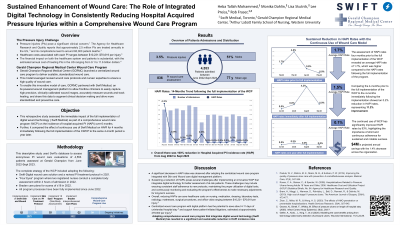Clinical Research
(CR-045) Sustained Enhancement of Wound Care: The Role of Integrated Digital Technology in Consistently Reducing Hospital Acquired Pressure Injuries within a Comprehensive Wound Care Program

Pressure injuries (PI) pose a significant challenge in the United States, resulting in a substantial financial burden on healthcare organizations,1 accounting for at least 3.6% of the annual health-setting budget.2 Healthcare organizations are shifting towards standardized, evidence-based PI best practices and wound care technology for optimal wound assessments.3
A US regional medical center (RMC) fully implemented a comprehensive wound care program (CWCP) in June 2022. This CWCP included a digital wound care solution (DWCS) to improve PI care, a revised treatment protocol, a complete body assessment within 4 hours of admission with two nurses, and Braden care plans for scores ≤18.
This descriptive study assessed the immediate impact of the full implementation of CWCP on the incidence of hospital-acquired PI (HAPI) over 6 months. Further, it compared the effect of continuous use of the CWCP on HAPI for 4 months immediately following the full implementation of the CWCP to the same 4-month period a year later.
Methods: The study used anonymous clinical data from the DWCS provider's database, focusing on unique PIs assessed between June 2022 and September 2023. New acquired PIs developed while under management at these organizations were investigated. Additionally, the RMC provided monthly admission numbers on 5,182 patients to calculate HAPI incidence rates for the study period. From June-Sept 2022, 1,145 patients were admitted to RMC and 1,432 were admitted in June-Sept 2023.
Results:
Overall, the incidence rate decreased by 4.2% over the initial six months following the full implementation of the CWCP (August 2022- Jan 2023). Moreover, the study showed a sustained decrease in HAPI rates after adopting the DWCS, with a 1.4% decrease in the incidence rate (1.5% in June-Sept 2022- 0.1% in June-Sept 2023), representing a 93% improvement in the last 4 months compared to the initial 4-months post-implementation.
Applying the 1.4% decrease observed in the study and the estimated PI healthcare costs at $10,231-$70,619 per injury 4 resulted in a projected annual savings of $600K-$4M.
Discussion:
Adopting a comprehensive wound care program that integrates digital wound technology has resulted in a significant and sustained reduction in HAPI incidence rates.

.jpeg)